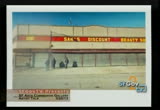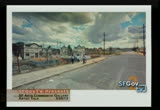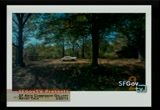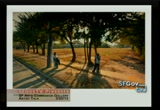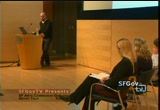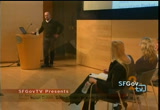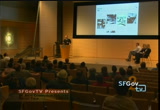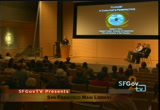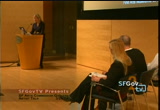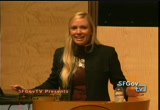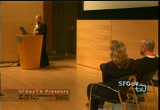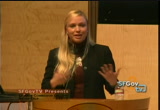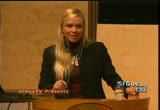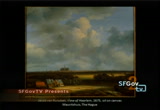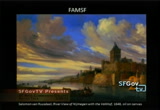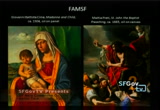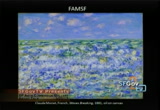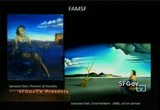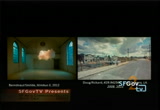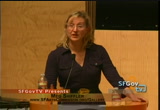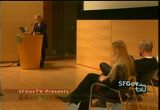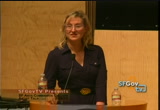tv [untitled] October 30, 2013 11:30pm-12:01am PDT
11:30 pm
think that truth is. google has taken these pictures of every cinch of our country for the most part and doing it in other countries as well. some of the other countries are resisting, germany, places where there is a history of big brotheresque type of regime. but for most of america we have welcomed it for the most part with open arms. we don't see the out pouring and out cry that we see in other countries. but the cars are going around and covering a 360 degree view, every 30 feet or so. and it is really a machine making the images, i have sort of come in and hijack that machine afterwards and pieced together a narrative from within this ocean of imagery. but they are going along and taking the pictures, and building up really a virtual space from within, which i traversed. and it was wild.
11:31 pm
it is sort of like a frozen world, really and there is movement of the camera, 360 degrees. but it is frozen. there are moments in time and in 2007. when this car goes by just like that and was gone, most of the time people don't know that there are pictures being taken and it really bakes into this work something different than the work that would be taken on the street. there is sort of visual connections to street photography and there is philosophical connections. you know there is some movement by me, that yet, the camera was a machine and it was taken from a height of about 7 feet of a fixed position. no one was wandering around and chosing various points of view and it presented to me this huge canvas of america, you know, that was pretty massive in terms of geography and yet
11:32 pm
just a small window and we don't see into these people's lives and we don't really know what is happening outside of the frame or where they are going and we don't know anything about them. so i went through exploring places that went from urban areas to small little towns along the border between mexico and the u.s. and a lits dusty towns or right in downtown baltimore and i spent a huge amount of time doing that. so if you think about it, this robot takes the picture and it takes a picture consistently from the same place and it is really i guess objective. more objective than any taking pictures. any journalist would also present a point of view. there is no point of view initially when these pictures were made, but then i am coming in and creating a point of view
11:33 pm
from within this ocean of imagery. as a flip through a few of these and let you look through these. you can see the city name down on the lower left, mississippi. the number next to the city is the derivative of the gps marker for this google location and i sort of transposed the numbers and used that. i wanted to connotate that virtual world and also there was a visual connection to the photographic heritage that was pretty wild. on top of this moment in time, there is also a breaking down of the imagery thaps in the google pictures themselves, most of these are lo fi and i chose that i guess because of
11:34 pm
the esthetics. it did not contain the same look as these and it also erode the truth and makes the lens a little bit blurry, it alters things from a technical point of view. so, you could see these pictures that sort of describe them as drive-by pictures that we are drive-by really captures this and not necessarily immersive in any way. it is literally a car driving by capturing a moment. some of this has been done in the past, walker evans took pictures out of a moving vehicle. in fact, strangely, right upstairs in the library before this talk i was looking through my side and i have on there a gallery from evans that is called drive by pictures and it
11:35 pm
is about 30 images of him flying down the road in mississippi and georgia and taking pictures of shot gun shacks and so forth from this moving car that was zipping along. and so there are other photographers that have explored the drive by. and in this case it was like i was hijacking this virtual world and also emerging myself in it. and i came to know these towns and these places almost in a way as if i ex-flowered it. it is really change, really a strange thing. and i know this super well, and i have never been there. >> i know every street in my mind i see the layout of the neighborhoods. you know the main streets and the turn offs? strange thing, i was thinking who would have thought that
11:36 pm
three decades ago that someone would be presenting a pick of america that was taken by machines and then hijacked and then represented, and reshown here in a library in san francisco? it just struck me as odd, i wonder what some of these prior photographers would have thought about it. it is sort of a new world in the way that we are throwing ourselves into a virtual world in a fast and furious way and we are glued to our phones for everything that we, you know, not everything, but we are all glued to our phones to a lot of what we learn and see. and we are increasingly looking at pictures as a language more so than it ever was. there would have been life magazine and newspapers and now the images are created on the order of 30 million a year are being added annually and that is growing and we are increasingly viewing our world through a virtual space.
11:37 pm
it is just really on overload. and so this work i guess is a symbol of that, in a way. color was important. there is color to represent america in a way. i wanted what i felt were american colors. certainly. how do you define american colors? you know? some of these things, existed within me and you know, sort of how i viewed america, right?
11:38 pm
some of these places may look entirely different in person. it is like a separate world here. even though it is reality, this really is a place and this really is a picture from google and anyone can go and look up these pictures when you leave here, you can ex-mror dallas yourself this way if you want. but in a way, there are these filters that are in front of everything that we view now and it has to do with choice, selection, treatment, the asthetic, how it is broken down or how clear it is. all of these things sort of enter into the equation and really make us question what true, truth is verses half truth.
11:39 pm
you know, i come from a photographic background. so it is different, you know? than than another artist approaching a platform like this. you can tell that i am looking for composition and certain themes that a photographer is driven to seek. these are just words. my first book that i did of this work i just opened it and i didn't want an essay or anything like that. and i just came up with key words like on a blog or a website, and i wanted the words all over the place, positive and negative all of it. basically american words,
11:40 pm
cheese berger, vegas, hooker. levee, armed forces. this is sort of the america that i have running through my head and it is filled with lots of themes and conflicting ideals and unifying ideals. and human ideals and material ideals. all of it. so i just did the brain storm over a week or so and just kept jotting down words and i keep sort of riffing into the american themes and this is a screen shot. and thes an archive and it is massive and i think that we are as artists are going to be sifting through the archives and how can you not when there are images being created and every has a digital slr in their hand or a camera in their phone and everyone can make a good picture now not everyone, but it is not, it gos beyond that and i can that we are going to look backwards as much as forwards. we are having all of this
11:41 pm
information in front of us. and people will sift through it, and bring ideas for it. and this is the utmost importance. and you can have the titles and they are pretty loaded, right? and it is something that interests me and i guess the loaded cop i cans in america to put it mildly interesting. the overhauled it and i published this site. and it is a huge archive and i looked at it as unlimited possibilities for editing and archiving and curating and publishing and i thought it was just amazing that i have the power at my fingertips to do anything that i wanted without any sort of limits only right here was the only limit and so the site really features other people's work and i don't put my work on it and it is
11:42 pm
basically, i thought, what can i do something like interview magazine like warhol did? i have the tools and i started five years ago and it has grown into huge proportions, i think when i checked there are 150,000 unique visitors a month reading it. so it has gotten quite an audience, but really it is something that i would love, it is just pure passion and it is also a self-education of mine on display and my own interest. and i think i will wrap it up. thanks. [ applause ] >> so for those of you who came in late, if you could hold your questions, we are not going to do a formal q, and a, but i will ask each of the panelists to stick around and if you want to chat with them one on one, they will be veil for a little
11:43 pm
while to do that. our next panelist is melissa. they earned her ba in 2005 and her ma in 2007. she worked in new york at christie's auction house and the time warner center, the museum experience includes the research positions in new york and the victor annual beter museum in london. she has been a member of the curtorial team of san francisco since 2008. and currently holds the position of assistant curator for european art. it has supported works from the 15th century, such as the mourners, cultures from the court of bergandy to the 19th century, including van gogh, and beyond master pieces. and she served as the assistant
11:44 pm
curator for the blockbuster, girl with the pearl earrings, including impressionists on the water and matice from sf mona to be honored later this year. we invited melissa to speak because he told me that his cloud series was inspired by growing up looking at dramatic skies in dutch landscape painting. welcome. >> thank you to everyone who came out this evening to the main branch of the public library, i felt like it was encased in a cloud with all of the fog and the rain and everything and so i have literally taken on this assignment with a great personal interest and i am seeing clouds everywhere. and when they first called one morning, and introduced herself and told me a little bit about
11:45 pm
this panel and this project i thought great, i know about clouds i see them every day and i work at the legend of honor, exposed to the sea with the massive mountains and clouds and i thought a piece of cake and i will just talk about clouds. it became a much deeper project but i started this talk thinking about my own biographical relationship with clouds and i was trolling through the photos on the computer and i realized that a lot of the moments that i felt important to capture, have something to do with the drama of the sky and the clouds and so here i did my masters degree in london and this is where i did a lot of research. and you get these amazing low lying clouds and of course this all resonates with the
11:46 pm
paintings that i look at and the work that i curate and this is the region of honor looking out across the golden gate bridge where we get some of the most dramatic and beautiful skies. and i recently had the opportunity to go to the national gallery of art in washington, d.c. and i was walking through the gallery and i got totally photo happy taking these pictures of clouds. and i realized that i needed to self-curate and refine it because when i was flying home to san francisco i was taking pictures of the clouds outside of the window of the plane and i thought that i just need to synthesize this and i did a little bit of looking around of what other art historians have said about clouds and land scapes there is a wonderful series called the met connections and the met museum of art has created this of talking about themes or other ideas that have to do with
11:47 pm
their permanent collection and of course, what did determine the european paintings department and assisting in nothing other than clouds. so i am in pretty big company here trying to talk about 550 years of clouds and art. but i will do my best in 15 minutes. i also found out in talking about clouds and conversation with other curators that there was an exhibition of the center for british art that existed the work of a man named mark lenard who was a painting at the getty museum and now at dal ace and he has worked on constable clouds and was so inspired by the work that he has done that he actually responded to the clouds in his own works. so clouds are very timely topic on many forums. and i just wanted to show you an exam el, the many, many types of studies of clouds
11:48 pm
trying to understand their three dimensionality and not giving you anything else on the composition other than the shapes of the clouds. even though the picture was made in 1822 it is very contemporary without the space. >> and back to the point of self-curating, and i started to think as an art historic when i became aware of clouds, when i start to think about them? we did an exhibition in 2011 at the duyong new see um which some of you may have seen was drawn from the collection in vienna and i brought an essay including saint sabastian and there is a detail in the clouds where you have a rider in the clouds. and art historians have not been able to agree on exactly what this figure is it a king, is it someone from mythology,
11:49 pm
but in any case, he has taken that childhood pass time of trying to see the shapes in the clouds and has created the shapes in the clouds of this painting. >> and some of you may have also seen our current exhibition with the girl with the pearl ear ring, there are not any clouds in this composition and i could not fabricate them and so i wanted to speak about this painting that is also in the collection of the maritz house it actually has three competitions and this was probably the most famous in the works in the collection up until the publication of the novel girl with the pearl ear ring and i will be doing a conversation with her next thursday, the 28th and that will be live google plus streamed. all sorts of fun technology. but before the publication of her book, and the subsequent film, this was probably one of
11:50 pm
the most famous compositions by verm ere, certainly the most famous, and has three paintings and i love that the way that the clouds hang so low and it is actually much darker on my screen, but this kind of balance between the rain clouds and the white pufffy clouds and the way that they interacts with the buildings in the city. this competes with two other paintings in the exhibition and i will not say which ones they are and it competes for my favorite painting in the exhibition it is view of harlem with bleaching grounds in the foregrounds and one of the most important innovations for the 17th century, dutch landscape painters was the way that they approached the sky. for any of you who have traveled to the netherlands you know that there is a low horizon line and i have been told that the dutch people and i can be corrected.
11:51 pm
that they call their clouds the dutch mountains because the landscape is so low that really you get these massive clouds in the sky and that is the kind of important topography to talk about. this is another example by the same artist and it is a winter scene, and as i move through these images of different paintings from various national schools. i don't want to talk too much over them but to let you feel how the atmosphere and the mood is changed by the different kinds of clouds that the artists have chosen to depict. and i wanted to also var clearly indicate it was interesting when putting together this powerpoint, i don't typically like to put any words on the images on the slides because i like the images in that way to speak for themselves, i feel like your eye competes between the words and images but i felt that it was important to differentiate
11:52 pm
between what is in our current exhibition and our permanent collection. so this is in the temporary exhibition as well. and then i wanted to let the paintings and the temporary exhibition and our permanent collection speak to each other and i started going through the permanent collection thinking about all of the ways that the clouds are represented in paintings starting with this early 16th century paintings by an artist nameds chima and i liked the way that the cloud offers like an extension of his halo and then you have this dramatic painting where the clouds are parting and it is like he is parting the red sea in the sky in this dramatic and emotional way that the clouds are not just offering but a part of the action and a part of the drama. and then you have got somebody like el greco who uses the
11:53 pm
clouds in this really violent and really nervous and really tense way. the clouds are vibrating with energy and they surround the figure of st. john the baptist in this very expressive way. so different than the other kinds of clouds that we were just looking at. and this is a painting by a norwegian artist named doll and i liked it because we have a nighttime scene and so you think about seeing the clouds in the daytime or the rain clouds or competitions of clouds that are over beautiful land scapes but what do the clouds do in this picture, when we are looking at the moon through the view of the clouds? and this is a painting that is particularly close to my heart. it is mid victor an artist named john martin and this painting is his depiction of the aftermath of the great biblical floods and so the clouds and waters are parting
11:54 pm
and you can't see it in this slide reproduction but in the actual painting very far in the horizon line you have noah and the arc. but the way that the clouds almost start to take on a figural representation, it is like there is a movement of hope and promise coming in the sky and of course the skies have this long history of being associated with the heavens and mythology. and you can't talk about clouds without talking about the impressionists. also on my mind since we are planning for the impressionist on the water exhibition which opens at the legend of honor june first. and this is a painting by the very-well monet and i was thinking back to constible. clouds where you don't get a figure you have a horizon and you get more of a sense of space and it is not just the clouds. but the whole canvas is taken
11:55 pm
up by water and sky and it is very architectural wave that he has construct td the brush work of the waiveds tossing in front of us. and then, imented to talk a little bit about the surrealist and i am about to install these paintings into what is traditionally our impressionist gallery. but they are some of the most popular paintings in our collection and when we don't have them i get people asking what have you done with them? and i think that doli's approach to many things is idiocyncratic and these clouds have a view, and they almost seemed figure all to me but they have this really expensive intention for lack of a better way to describe them. i don't know that he would have wanted me describing them.
11:56 pm
>> i really love this image, and i think as we have heard from the other panelists, clouds and space and landscape have a personal meaning and what we project on them is very subjective and i think that in my own attempt to synthesize art history in 15 minutes and looking at clouds and skies, i came to realize that there is a personal vocabary that we project on to these images. and so i felt honored to have participated on this panel and so i feel like it is really changed the way that i look at so many kinds of paintings and i thought about creating a exhibition on clouds and trying to take this project even further and i think that there is really a lot to be said for
11:57 pm
something that we take for granted perhaps on a daily basis, but much deeper meaning to be read. thank you to meg and the panelists and thank you to the audience. [ applause ] >> 550 years in 15 minutes. nicely done. i want to thank our panelists so much. let's give them a hand. thank you. >> i want to leave you with a few thoughts. conversation six, i don't know if many of you know this, but is our final exhibition in our current space in main gallery in the veteran's building, that whole building is being retrofit for two years. when we reopen in 2015, we will have 4400 square feet. and we have 900 square feet right now. so it is going to be a
11:58 pm
remarkable new space. and we will be doing a lot of sort of institutional soul searching as to how we can serve the public and create an exhibition program in the large new facility that fills in gaps here in our cultural stratta and how we can serve a wide variety of artists and communities, and represent san francisco in a way that we do currently which is by showing regional artists alongside of artists from other places, developing a dialogue between the local, the national and the international. so we will carry that forward in the new facilities. in the meantime we will continue to program at city hall and at the window installation sites. so we are not going dark. we are just, we are putting on hold one of our three different programs. and i want to leave you with
11:59 pm
one final thought. for the last week bear not has been here and i have been witnessing him make a cloud in the green room of the veteran's building which is on the second floor of that building and overlooks for a balcony that overlooks city hall for those of you who have been there for private functions. >> it is an extraordinary room, it is the american pizza hut version of the hall of mirrors one might say. it is a gorgeous room. and we were reviewing the final edit of this new piece that will enter into the nimbus series and it will be on view at the gallery in a couple of weeks and again, watch your e-mail and we will let you know when it arrives and you can come and look at it.
12:00 am
there will be two images chosen from this large multiday, one is a large print that will be on view in the gallery and is an addition of six. and then, we have been sort of talking about addition size and then there will be a version that is about this big. that is an addition of 30 and available for purchase at a affordable price. so let us know if you are interested in that and watch the e-mail and the funds will go to both support the artist and support the programs at the arts commission as we move forward. so sign up for our eblast and keep in touch and thank you so much for coming tonight. we will hang out for just a little bit and answer questions, and you can come by and see the exhibition wednesday through saturday, 12 to five. thank you so much.
71 Views
IN COLLECTIONS
SFGTV2: San Francisco Government Television Television Archive
Television Archive  Television Archive News Search Service
Television Archive News Search Service 
Uploaded by TV Archive on

 Live Music Archive
Live Music Archive Librivox Free Audio
Librivox Free Audio Metropolitan Museum
Metropolitan Museum Cleveland Museum of Art
Cleveland Museum of Art Internet Arcade
Internet Arcade Console Living Room
Console Living Room Books to Borrow
Books to Borrow Open Library
Open Library TV News
TV News Understanding 9/11
Understanding 9/11